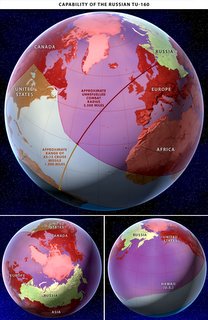Russia's Unique Military Position - Jan 9
Got a really good one here from stratfor about Russian bomber capabilities. Very interesting stuff. Anyways, in lieu of a real post that requires some actual effort I've done a cut and paste job for you here instead. Click on the big map below to get a larger view.
Johnny Cash

Russia: Maintaining a Unique Military Position
Jan 09, 2007
Summary
In 2006, Russian strategic aviation conducted more than 100 training sorties over the old Cold War battleground of the Northern Atlantic, Northern Pacific and Arctic oceans, Russian air force Commander-in-Chief Gen. Vladimir Mikhailov announced. While the sorties are neither especially impressive nor particularly concerning to Washington, they are a reminder of Russia's unique military position, especially vis-a-vis the United States.
Analysis
Russian air force Commander-in-Chief Gen. Vladimir Mikhailov said Jan. 4 that Russian planes flew more than 100 strategic bomber patrols over Russia's eastern, western and northern periphery in 2006. Mikhailov said the sorties indicate a new level of combat readiness for Russia's long-range strategic air force.
The aviation exercises are in line with a general Russian military resurgence that has been under way for some time. Building a new Russian military from the shambles of the Red Army is a massive and daunting task. But key forces -- strategic nuclear forces, aviation and elite ground units -- are being reconstituted. The current pace is admittedly slow, but it is steady. The selective rehabilitation of Russia's military capabilities is coupled with the Kremlin's increasing control over the strategic energy and mining sectors and the political landscape. With major elections coming in December 2007 and March 2008, the Kremlin wishes to consolidate as much power as possible to ensure the perpetuation of its current policies. Thus, Russian military rhetoric has become more for domestic consumption, intended to show the Russian people what Moscow has done to rebuild its strategic position in the world.
However, the strategic aviation patrols in the old Cold War style are also a reminder that Russia holds a unique position of military power vis-a-vis the United States. Though the Soviet Union is no more, its achievements in military technology -- especially those just coming online when the Berlin Wall came down -- remain in the hands of the Russian armed forces today. There is no clearer example of this than the Tupolev Tu-160 bomber (designated "Blackjack" by NATO).
Besides the United States and Russia, no other nation possesses such a strategic strike platform -- and none appears likely to have one in the near future. Similar in appearance to the U.S. B-1B, the Tu-160 is some 30 feet longer and has a maximum wingspan more than 40 feet greater. It is some 125,000 pounds heavier than the B-1B, and each engine kicks in 55,000 pounds of thrust in afterburner -- 25,000 pounds more than the B-1B. Capable of traveling at Mach 2.05, the Blackjack is nearly twice as fast as the B-1B. This is not to say that the Tu-160 is a superior plane in all respects; its cruise speed is slower, its ordnance load about 10,000 pounds less and its avionics and navigation capabilities are not as evolved, but these are minor distinctions in the context of the world's air forces.
The Tu-160 can, without refueling, deliver ordnance halfway around the world from Russian territory. Moreover, it can launch a dozen KH-55 cruise missiles (designated AS-15 by NATO) with an additional range of roughly 1,800 miles and a circular error probable (a measure of accuracy) of about 80 feet. Tu-160 airframes have been slowly receiving upgraded systems and the capability to carry additional types of ordnance since the summer of 2006.
While Russian pilots still do not receive stellar amounts of flying time -- and flying time is an important measure of an air force's true skill level -- select squadrons like the Tu-160s of the 121st Heavy Bomber Aviation Regiment stationed at Engels Air Force Base near Saratov are now getting a disproportionate increase in training in order to correct this deficiency.
As Russia rebuilds its military, it is taking advantage of the significant stepping stone of legacy Soviet platforms like the Tu-160. While this by no means translates into a Russian ability to penetrate U.S. airspace and hit strategic targets, Moscow and Washington alone can quickly strike at targets around the world on short notice.
Moscow still officially considers the United States and NATO its top defense priority. Though nuclear strategists keep a close eye on Russia, the United States and NATO do not see Moscow as a top threat. The withdrawal of U.S. P-3 Orions from Iceland is only a small indication of this. Though the West has not forgotten Russia's military -- especially its strategic nuclear forces -- the time could come when an unexpected Tu-160 strike in defense of Russian interests in some remote locale reminds the world that, while down, the Russian war machine is definitely not out.
Copyright 2007 Strategic Forecasting Inc. All rights reserved.




No comments:
Post a Comment